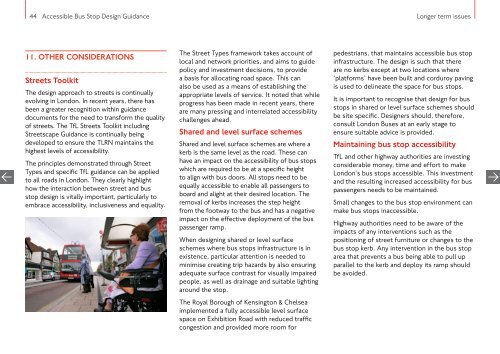ACCESSIBLE BUS STOP DESIGN GUIDANCE
bus-stop-design-guidance
bus-stop-design-guidance
Create successful ePaper yourself
Turn your PDF publications into a flip-book with our unique Google optimized e-Paper software.
44 Accessible Bus Stop Design Guidance<br />
Longer term issues<br />
11. OTHER CONSIDERATIONS<br />
Streets Toolkit<br />
The design approach to streets is continually<br />
evolving in London. In recent years, there has<br />
been a greater recognition within guidance<br />
documents for the need to transform the quality<br />
of streets. The TfL Streets Toolkit including<br />
Streetscape Guidance is continually being<br />
developed to ensure the TLRN maintains the<br />
highest levels of accessibility.<br />
The principles demonstrated through Street<br />
Types and specific TfL guidance can be applied<br />
to all roads in London. They clearly highlight<br />
how the interaction between street and bus<br />
stop design is vitally important, particularly to<br />
embrace accessibility, inclusiveness and equality.<br />
The Street Types framework takes account of<br />
local and network priorities, and aims to guide<br />
policy and investment decisions, to provide<br />
a basis for allocating road space. This can<br />
also be used as a means of establishing the<br />
appropriate levels of service. It noted that while<br />
progress has been made in recent years, there<br />
are many pressing and interrelated accessibility<br />
challenges ahead.<br />
Shared and level surface schemes<br />
Shared and level surface schemes are where a<br />
kerb is the same level as the road. These can<br />
have an impact on the accessibility of bus stops<br />
which are required to be at a specific height<br />
to align with bus doors. All stops need to be<br />
equally accessible to enable all passengers to<br />
board and alight at their desired location. The<br />
removal of kerbs increases the step height<br />
from the footway to the bus and has a negative<br />
impact on the effective deployment of the bus<br />
passenger ramp.<br />
When designing shared or level surface<br />
schemes where bus stops infrastructure is in<br />
existence, particular attention is needed to<br />
minimise creating trip hazards by also ensuring<br />
adequate surface contrast for visually impaired<br />
people, as well as drainage and suitable lighting<br />
around the stop.<br />
The Royal Borough of Kensington & Chelsea<br />
implemented a fully accessible level surface<br />
space on Exhibition Road with reduced traffic<br />
congestion and provided more room for<br />
pedestrians, that maintains accessible bus stop<br />
infrastructure. The design is such that there<br />
are no kerbs except at two locations where<br />
‘platforms’ have been built and corduroy paving<br />
is used to delineate the space for bus stops.<br />
It is important to recognise that design for bus<br />
stops in shared or level surface schemes should<br />
be site specific. Designers should, therefore,<br />
consult London Buses at an early stage to<br />
ensure suitable advice is provided.<br />
Maintaining bus stop accessibility<br />
TfL and other highway authorities are investing<br />
considerable money, time and effort to make<br />
London’s bus stops accessible. This investment<br />
and the resulting increased accessibility for bus<br />
passengers needs to be maintained.<br />
Small changes to the bus stop environment can<br />
make bus stops inaccessible.<br />
Highway authorities need to be aware of the<br />
impacts of any interventions such as the<br />
positioning of street furniture or changes to the<br />
bus stop kerb. Any intervention in the bus stop<br />
area that prevents a bus being able to pull up<br />
parallel to the kerb and deploy its ramp should<br />
be avoided.



